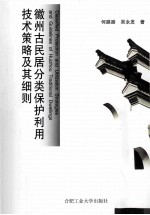图书介绍
徽州古民居分类保护利用技术策略及其细则PDF|Epub|txt|kindle电子书版本网盘下载

- 何路路,吴永发编 著
- 出版社: 合肥:合肥工业大学出版社
- ISBN:9787565008146
- 出版时间:2012
- 标注页数:303页
- 文件大小:46MB
- 文件页数:327页
- 主题词:民居-保护-徽州地区
PDF下载
下载说明
徽州古民居分类保护利用技术策略及其细则PDF格式电子书版下载
下载的文件为RAR压缩包。需要使用解压软件进行解压得到PDF格式图书。建议使用BT下载工具Free Download Manager进行下载,简称FDM(免费,没有广告,支持多平台)。本站资源全部打包为BT种子。所以需要使用专业的BT下载软件进行下载。如BitComet qBittorrent uTorrent等BT下载工具。迅雷目前由于本站不是热门资源。不推荐使用!后期资源热门了。安装了迅雷也可以迅雷进行下载!
(文件页数 要大于 标注页数,上中下等多册电子书除外)
注意:本站所有压缩包均有解压码: 点击下载压缩包解压工具
图书目录
第1章 绪论1
1.1 研究背景及意义2
1.1.1 问题的提出2
1.1.2 徽州古民居分类保护利用的研究意义4
1.1.3 徽州古民居分类保护利用的研究目标5
1.1.4 采用分类方法研究徽州古民居保护利用的原因6
1.2 国内外建筑遗产保护利用的发展概况7
1.2.1 西方建筑遗产保护利用理论研究情况7
1.2.2 我国古民居保护利用理论研究情况11
1.2.3 研究情况总结14
1.3 研究框架15
1.3.1 研究内容15
1.3.2 研究方法15
1.3.3 本书框架的建立16
第2章 徽州古民居保护利用的类型划分18
2.1 古民居保护的相关概念及范围18
2.1.1 建筑遗产、文物和文物保护单位18
2.1.2 历史性建筑19
2.1.3 保护、修复、改造等21
2.1.4 建筑再利用21
2.1.5 技术策略及其细则23
2.2 前期准备23
2.2.1 资料收集23
2.2.2 现状建筑测绘24
2.2.3 古民居残损勘测25
2.3 古民居分类的几种模式与方法25
2.3.1 根据“内在价值”对古民居进行分类26
2.3.2 根据“可利用价值”对古民居进行分类28
2.3.3 根据“文物保护法规”对古民居进行分类30
2.3.4 根据“现状问题及对策”对古民居进行分类30
2.4 徽州古民居保护利用的类型划分31
2.4.1 几种古民居分类模式的综合与比较31
2.4.2 徽州古民居保护利用的类型划分32
第3章 类型一:原真性保护利用技术策略细则36
3.1 原状保护37
3.1.1 一般规定37
3.1.2 周边环境39
3.1.3 天井院落41
3.1.4 古民居修缮42
3.1.5 构造、材料50
3.1.6 立面及形式52
3.1.7 色彩52
3.2 有限利用53
3.2.1 一般规定53
3.2.2 外部环境54
3.2.3 建筑形态55
3.2.4 建筑功能55
3.3 案例分析57
第4章 类型二:生活性保护利用技术策略细则60
4.1 基础设施60
4.1.1 一般规定60
4.1.2 日常维护、防潮、消防、抗震61
4.1.3 卫生间、厨房改造及沼气利用65
4.1.4 节能设计66
4.1.5 给排水69
4.1.6 电气70
4.2 居住功能布局71
4.2.1 一般规定71
4.2.2 居住条件标准72
4.2.3 居住功能布局74
4.3 案例分析77
第5章 类型三:新业态保护利用技术策略细则80
5.1 内部功能改造81
5.1.1 一般规定81
5.1.2 新业态的确定82
5.1.3 结构加固84
5.1.4 新业态功能改造85
5.2 外部形态控制88
5.2.1 一般规定88
5.2.2 形式、体量及高度89
5.2.3 色彩、材料及装饰构件91
5.3 案例分析93
第6章 类型四:异地保护利用技术策略细则96
6.1 异地集中保护利用97
6.1.1 一般规定97
6.1.2 迁移范围98
6.1.3 迁移方案100
6.1.4 集中迁移利用104
6.2 异地单体保护利用107
6.2.1 一般规定107
6.2.2 迁移范围107
6.2.3 迁移方案107
6.2.4 单体迁移利用107
6.3 案例分析109
第7章 总结112
7.1 技术策略及其细则的汇报讨论情况113
7.2 研究的局限性115
7.3 后续研究建议116
参考文献117
关键词索引119
英文版121
Chapter One Preface121
1.1 Background and Significance of the Study123
1.1.1 Problems Introduction123
1.1.2 Research Significance of Classified Protection and Utilization of Huizhou Traditional Dwellings126
1.1.3 Research Objectives of Classified Protection and Utilization of Huizhou Traditional Dwellings129
1.1.4 Study on the Reasons for Protection and Utilization of Huizhou Traditional Dwellings by Classification131
1.2 Domestic and International Development of Protection and Utilization of Architectural Heritage132
1.2.1 Western Theoretical Study on Protection and Utilization of Architectural Heritage132
1.2.2 Domestic Theoretical Study on Protection and Utilization of Traditional Dwellings137
1.2.3 Research Summary143
1.3 Research Framework143
1.3.1 Research Content143
1.3.2 Research Methods145
1.3.3 The Book's Framework and Structure Diagram146
Chapter Two the Classification of Protection and Utilization of Huizhou Traditional Dwellings148
2.1 Relevant Concepts and Scope of the Protection of Traditional Dwellings148
2.1.1 Architecture Heritage,Cultural Relic and Protected Monument149
2.1.2 Historic Architecture150
2.1.3 Protection,Restoration,Transformation,etc152
2.1.4 Utilization of Architecture153
2.1.5 Technical Strategies and Guidelines155
2.2 Preparation156
2.2.1 Data Collection156
2.2.2 Architectural Surveying and Mapping of Status quo158
2.2.3 Damage Survey on Traditional Dwellings159
2.3 Classification Modes and Methods of Traditional Dwellings159
2.3.1 Classify the Traditional Dwellings According to Intrinsic Value160
2.3.2 Classify the Traditional Dwellings According to Utility Value163
2.3.3 Classify the Traditional Dwellings According to Laws and Regulations of Culture Relics Protection166
2.3.4 Classify the Traditional Dwellings According to Status quo Problems and Countermeasures166
2.4 Classification of Protection and Utilization of Huizhou Traditional Dwellings168
2.4.1 Integration and Comparison of Classification Modes of Traditional Dwellings169
2.4.2 Classification of Protection and Utilization of Huizhou Traditional Dwellings170
Chapter Three Type One:Strategies and Guidelines of Protection&Utilization of Authenticity177
3.1 Maintenance of Original Features178
3.1.1 General Rules178
3.1.2 Surrounding Environment182
3.1.3 Patio Courtyard185
3.1.4 Residential Renovation186
3.1.5 Structure and Material197
3.1.6 Elevation and Form200
3.1.7 Color201
3.2 Limited Use202
3.2.1 General Rules202
3.2.2 External Circumstances203
3.2.3 Architecture Morphology205
3.2.4 Architecture Function206
3.3 Case Analysis208
Chapter Four Type Two:Strategies and Guidelines of Protection&Utilization of Living Environment212
4.1 Infrastructure213
4.1.1 General Rules213
4.1.2 Routing Maintenance,Damp Proofing,Fire Control,Seismic Resistance214
4.1.3 Transformation of Bathroom and Kitchen and Utilization of Methane219
4.1.4 Energy-saving Design222
4.1.5 Water Supply and Drainage226
4.1.6 Electricity227
4.2 Layout of Living Function230
4.2.1 General Rules230
4.2.2 Standard of Living Conditions230
4.2.3 Layout of Living Function233
4.3 Case Analysis239
Chapter Five Type Three:Strategies and Guidelines of Protection&Utilization of New Functions242
5.1 Internal Function Transformation243
5.1.1 General Rules243
5.1.2 Determination of New Functions246
5.1.3 Structural Reinforcement248
5.1.4 Transformation of New Functions250
5.2 External Morphology Control255
5.2.1 General Rules255
5.2.2 Form,Volume and Height256
5.2.3 Material,Color and Decorative Elements260
5.3 Case Analysis263
Chapter Six Type Four:Strategies and Guidelines of Protection&Utilization of Off-site Dwellings266
6.1 Off-site Comprehensive Protection and Utilization266
6.1.1 General Rules266
6.1.2 Relocation Scope270
6.1.3 Relocation Scheme272
6.1.4 Comprehensive Relocation and Utilization279
6.2 Off-site Individual Protection and Utilization284
6.2.1 General Rules284
6.2.2 Relocation Scope284
6.2.3 Relocation Scheme284
6.2.4 Individual Relocation and Utilization284
6.3 Case Analysis287
Chapter Seven Conclusion291
7.1 Discussion and Reporting of Strategies and Guidelines293
7.2 Limitations of Research296
7.3 Suggestions on Follow-up Study298
Bibliography299
Keywords Index302